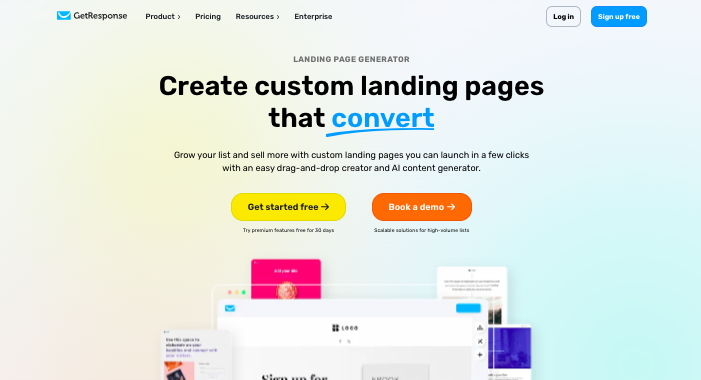When it comes to digital marketing, finding the right platform can make all the difference in the success of your campaigns.
In this post, we are going to review two popular platforms, GetResponse and Pardot. We will explore all their sides including features, benefits, pros and cons among other things.
By the end of it, you’ll be better equipped to make the right decision for your marketing needs.
Let’s begin.
What is GetResponse? Discuss its Top Features
GetResponse is an email marketing platform that helps businesses build valuable contact lists, create and send effective email campaigns, and automate marketing tasks.
Here are the key benefits of using GetResponse:
Comprehensive Email Marketing Tools
GetResponse provides a wide range of features for email marketing, including:
- Drag-and-drop email editor to create professional-looking newsletters and campaigns
- Autoresponders to automatically follow up with customers
- A/B testing to optimize email content and subject lines
- Detailed analytics to track campaign performance
Landing Page Builder
- GetResponse allows you to create high-converting landing pages without any coding.
- You can test different page designs and optimize them for better conversions.
Marketing Automation
- GetResponse’s automation workflows let you create automated processes to nurture leads and customers based on their actions and behaviors.
- This helps you deliver personalized experiences at scale.
Webinar Integration
- GetResponse has built-in webinar functionality, allowing you to host live or automated webinars to generate leads and engage your audience.
- This is a unique feature compared to many other email marketing platforms.
Sending emails, creating landing pages, automating marketing, building conversion funnels, boosting sales, everything made easier with GetResponse.
Affordable Pricing
- GetResponse is competitively priced, especially when you consider the breadth of features it offers.
- There is also a free plan available for sending upto 2500 emails/month.
Excellent Deliverability
- GetResponse boasts a 99.5% email deliverability rate, ensuring your messages reach your subscribers’ inboxes.
Ease of Use
- The GetResponse platform is intuitive and user-friendly, with helpful guides and customer support to assist you.
In short, GetResponse provides a comprehensive set of email marketing, landing page, and marketing automation tools that can help businesses of all sizes grow their online presence and revenue.
What is Pardot? What are its Notable Features?
Pardot is a B2B marketing automation platform that helps businesses create and send personalized email campaigns, build landing pages, and track prospect engagement.
It was a part of ExactTarget, which Salesforce acquired in 2013. Pardot is the legacy product name for Marketing Cloud Account Engagement. The product is the same.
Using Pardot or Marketing Cloud Account Engagement tool gives you several benefits.
Comprehensive Email Marketing Tools
- Drag-and-drop email editor to create professional-looking newsletters and campaigns
- Autoresponders to automatically follow up with prospects
- A/B testing to optimize email content and subject lines
- Detailed analytics to track campaign performance
Prospect Tracking and Scoring
- Pardot allows you to track prospect behavior on your website, such as pages visited and forms filled out.
- You can then assign scores to prospects based on their engagement level, helping sales prioritize leads.
Salesforce Integration
- Pardot is owned by Salesforce and integrates seamlessly with the Salesforce CRM.
- This allows you to sync prospect data between the two platforms and have sales and marketing work from a single view of the customer.
Marketing Automation
- Pardot’s automation workflows let you create automated processes to nurture leads based on their actions and behaviors.
- This helps you deliver personalized experiences at scale.
Landing Page Builder
- Pardot allows you to create high-converting landing pages without any coding.
- You can test different page designs and optimize them for better conversions.
Ease of Use
- Pardot is known for being user-friendly, with an intuitive interface and helpful guides.
- This makes it accessible for marketers of all skill levels.
Pardot provides a comprehensive set of automation tools that help B2B companies streamline their lead generation and nurturing processes.
Its Salesforce integration, prospect tracking capabilities, and ease of use make it a popular choice for businesses looking to improve their marketing ROI.
Also Read: GetResponse vs Sendgrid
What Types of Businesses Benefit Most from Using GetResponse?
From SMBs to global businesses, GetResponse is for everyone.
Take a look how you can benefit from it.
Small and Medium Businesses (SMBs)
- GetResponse provides a user-friendly platform and comprehensive email marketing tools that can help SMBs streamline their marketing efforts and save time.
- The marketing automation features like lead scoring and nurturing workflows allow SMBs to better prioritize leads and deliver personalized experiences at scale.
- The seamless integration with Salesforce CRM helps align marketing and sales teams for SMBs.
B2B Companies
- GetResponse’s prospect tracking and scoring capabilities are particularly beneficial for B2B companies with complex sales cycles, allowing them to qualify leads based on engagement.
- The marketing automation workflows help B2B companies build efficient sales pipelines by nurturing leads through personalized communications.
- The webinar hosting feature is useful for B2B firms to generate leads and engage their audience in real-time.
Sending emails, creating landing pages, automating marketing, building conversion funnels, boosting sales, everything made easier with GetResponse.
Businesses with Global Reach
- GetResponse’s ability to handle large contact lists and deliver high email deliverability makes it suitable for businesses with a global customer base.
- The platform’s multilingual support and localization options allow businesses to personalize their marketing campaigns for different regions and markets.
The time and cost savings, improved lead management, and better ROI measurement are key benefits that drive GetResponse’s popularity across various industries.
Who Benefits the Most from using Pardot?
Businesses of all sizes can benefit from using Pardot, but it is especially advantageous for B2B companies and those with complex sales cycles.
Here are some of the key benefits that make Pardot a great choice for various businesses:
Small and Medium Businesses (SMBs)
- Automates marketing communications to save time for marketing and sales teams
- Implements lead scoring to help prioritize leads sent to the sales team, making them more efficient
- Provides data-driven insights to inform better marketing decisions
- Integrates with Salesforce CRM to align marketing and sales
B2B Companies
- Gives a full life-cycle view of prospects to qualify them based on interactions and profile
- Helps build an efficient sales pipeline to maximize engagement while minimizing irrelevant messaging
- Aligns marketing and sales teams through lead qualification and nurturing
- Increases engagement with prospects and clients through lead nurturing campaigns
Businesses with Complex Sales Cycles
- Tracks prospect interactions with marketing touchpoints across the full life-cycle
- Automates prospect segmentation and qualification using rules and dynamic lists
- Measures ROI on digital marketing activity to see which campaigns are performing best
- Integrates directly with Salesforce to sync prospects, leads, contacts and opportunities
Enterprises
- Expands marketing reach beyond geographic boundaries through multiple channels
- Manages customer contact information in one place to improve brand management
- Creates comprehensive audience profiles to develop targeted sales and marketing campaigns
- Offers a centralized database for easy access to customer preferences and personal data
Explore: GetResponse vs MailChimp
Are there Any Cons of Using GetResponse?
Despite the numerous benefits GetResponse offers, it has certain drawbacks:
- Complexity in Creating Complex Campaigns: GetResponse can be challenging to create complex email marketing campaigns, which may require advanced coding skills.
- Loading Time Issues: The platform’s loading time can be slow, causing rough designs to appear before the full page loads, which can be frustrating for users.
- Limited Design Flexibility: Users have reported difficulties in designing landing pages and emails, as elements do not move or behave as expected, and the font choices are limited.
- Outdated Interface: The user interface feels outdated and slow, which can be a significant drawback for users who expect a more modern and responsive experience.
- Expensive for Large Lists: As the list size grows, GetResponse can become expensive quickly, which may not be cost-effective for businesses with large email lists.
- Customer Service: Some users have reported difficulty accessing customer service, which can be a significant issue when encountering technical problems or needing assistance.
- Limited Responsive Forms: GetResponse does not provide responsive forms for mobile devices, which is a significant drawback in today’s mobile-first environment.
- Clunky Navigation: The user interface can be clunky and difficult to navigate, making it hard to find the features you need.
- Limited Control Over Email Content: Users have reported issues with controlling the GetResponse information and unsubscribe at the bottom of the email, which can affect branding consistency.
- Slow Analytics: The analytics provided by GetResponse can be slow and confusing, which can hinder the ability to optimize campaigns effectively.
Where does Pardot Lack?
Some of you might find Pardot lacking in the following areas:
- Price: Pardot is relatively expensive, with the basic plan starting over $1,000 per month, billed annually. This can be a significant cost for smaller businesses.
- A/B Testing Limitations: A/B testing for emails and landing pages is only available in the more expensive Pro subscription plan. This feature is included in some other marketing automation platforms at lower price points.
- Lack of Social Media Management: Pardot does not have robust social media management capabilities, so users would need to use a separate tool for tasks like monitoring social accounts and scheduling posts.
- Complexity and Learning Curve: Pardot is a comprehensive platform with many advanced features. This can lead to a steeper learning curve compared to simpler marketing automation tools, especially for users new to marketing automation.
- Limited Integrations: Pardot only has around 30 third-party app integrations, which is fewer than some competing platforms. However, it does integrate well with Salesforce’s CRM.
- API Access Restrictions: The API is only available with the higher-tier Plus and Advanced Pardot plans, limiting integration capabilities for users on the basic plan.
- Outdated User Interface: Some users have reported that the Pardot interface feels dated and less intuitive compared to more modern marketing automation platforms.
With limitations like these, it’s a good idea to carefully evaluate whether Pardot’s capabilities justify the higher price point compared to other options.
Pricing
GetResponse
GetResponse offers a range of pricing plans tailored to different business needs.
Here is a brief overview:
- Free Plan: Offers basic features like 1 landing page, website builder, signup forms, popups, and unlimited newsletters, all for free
- Email Marketing Plan: Starts at $15.6 per month. This plan includes email marketing features like email support, 24/7 live chat, integrations, reporting, and more
- Marketing Automation Plan: Starts at $48.4 per month and includes advanced marketing automation features like webinars, multi-user support, and conversion funnels
- Ecommerce Marketing Plan: Starts at $97.6 per month and is designed for e-commerce businesses, offering features like product delivery and order forms
- MAX Plans: For larger businesses, these plans start at $1099 per month and include advanced features like SMS marketing, multiple websites, and dedicated support.
Sending emails, creating landing pages, automating marketing, building conversion funnels, boosting sales, everything made easier with GetResponse.
In addition, you also have the option to pay biannually or every month. The above prices are applicable for yearly payments. They also offer a 30-day trial period.
Pardot
Pardot offers several pricing tiers to accommodate businesses of different sizes and needs:
Pardot Growth: $1,250 per month
- Includes basic marketing automation features like email marketing, lead generation, lead nurturing, and lead scoring
- Suitable for small businesses just getting started with marketing automation
Pardot Plus: $2,750 per month
- Adds more advanced email marketing, lead generation, and lead nurturing capabilities
- Provides access to features like advanced automation, personalization, and qualification
Pardot Advanced: $4,400 per month (most popular)
- Includes all Plus features plus advanced analytics, reporting, business units, and AI-powered capabilities
- Designed for larger enterprises with complex marketing needs
Pardot Premium: $15,000 per month
- The most comprehensive tier with predictive analytics, personalized product support, and other enterprise-grade features
- Targeted at large organizations with extensive marketing automation requirements
The pricing is based on the number of contacts and the specific features included in each edition.
Pardot also offers add-ons like custom objects and user permissions for an additional cost.
Conclusion
The choice between GetResponse and Pardot depends on your business’s specific needs and budget.
If you need a more affordable and user-friendly solution with email marketing and automation as your primary requirement, GetResponse will fit in nicely.
However, for advanced marketing needs and deep integration with Salesforce, Pardot will work.














